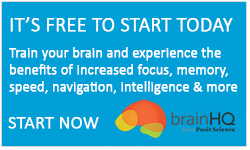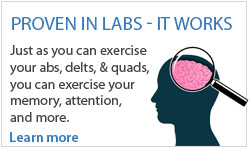10 Brain Exercises for Seniors: Exercise #5 Double Decision

Double Decision is the current version of the speed training cognitive intervention used in the ACTIVE study. To learn more about the study and try the exercise, please click here.
Slips, collisions and falls are a hazard at any age, but unfortunately, in older adults the effects can be much more debilitating. Risk of falls increases as we age as well as the severity of the injuries sustained from an accident like this. If that weren’t enough, one incident often leads to a downward spiral as fear of future falls limits mobility further with the added effect of increasing the risk of another fall, yet again. It may seem like this is just a matter of aging legs not being as quick or strong as they once were, but it’s not as simple as that. There are many cognitive and sensory functions at play behind what we think of as simply balancing ourselves. The majority of recurrent falls are more likely tied to issues with the vestibular system of the inner ear, visual-spatial processing or the visual-motor systems.
The visual-spatial process in our brains includes functions such as visual speed, attention, acuity and useful field of view. Or, to think of it another way, it is how we see ourselves in relation to the world around us. Being able to take in information and process it quickly and precisely helps our brains adjust our bodies to any sudden changes around us. For instance, say you are walking along the sidewalk and someone texting on his or her phone walks directly into your path. Being able to see this happening sooner allows your brain to process all the relevant information to help avoid what may otherwise feel like an inevitable collision and fall. This situation relies on something called our “useful field of view,” which unfortunately, decreases as we age.
To help increase your useful field of view, the double decision exercise has been built around the proven method of having you focus on a central task yet challenge you to see something at the periphery. As you progress in the exercise, the peripheral object extends farther and farther away from the centre to expand your useful field of view. At the same time, there will be increasingly subtle differences to the central object you need to identify in comparison to incorrect solutions. As your brain is pushed to identify more detail in an increasingly more complex background and an ever expanding area, it trains itself to better identify and store useful information. Taking steps to have a more efficient visual process in your brain, means you can help reduce your risk of falls, improve driving safety and better maintain your health, mobility and independence.
Free Brain Training Exercises
If you are interested in trying this exercise and other BrainHQ exercises for free, visit https://dynamicbrain.brainhq.com and create a free account to exercise a few minutes a day – it’s not enough, but definitely better than no exercise at all.
Don’t forget to bookmark the link!
Related Pages:
Fall Risk and Mobility
Description of Double Decision Exercise
https://dynamicbrain.brainhq.com
https://dynamicbrain-fr.brainhq.com
DynamicBrain Inc. is the Canadian Partner of Posit Science Corporation providing brain fitness program, BrainHQ in English and French.






 English
English
 Français
Français


